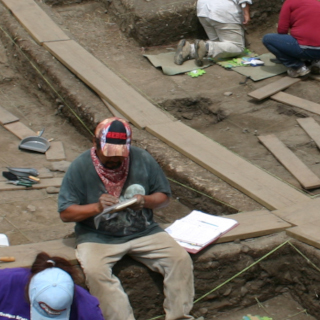Research Activities
The Bridge River Archaeological Project is an interdisciplinary collaborative effort involving contributions from First Nations members, archaeologists, zooarchaeologists, paleoethnobotanists, geoarchaeologists, and other scientists including experts in ancient DNA and isotopic analysis of animal bones. Our current goal is to develop a comprehensive perspective on life in Housepit 54 across its many centuries of occupation. In accomplishing this we gain a better understanding Middle Fraser Canyon First Nations history and we address critical anthropological questions regarding the origins of village life, population growth and decline, social organization, technology, and Colonial encounters and relationships.
2016 was the final field season of excavations at Housepit 54, as always conducted as a collaborative partnership with Xwísten, the Bridge River Indian Band. We continued to enjoy our ongoing work with the staff of Xwísten Experience Tours educating tourists and locals alike regarding St’át’imc and Xwísten heritage from the standpoint of archaeology.
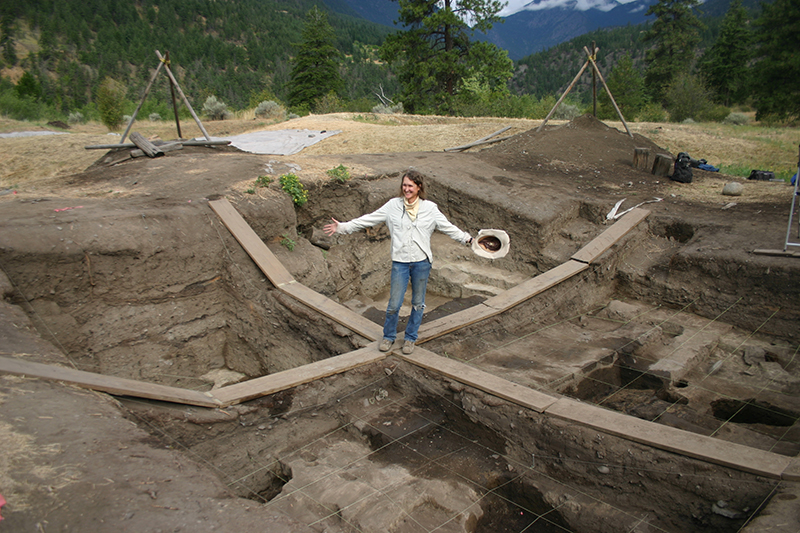
Housepit 54 offered many surprises in 2016. Our team confirmed the presence of a stratified sequence of 17 floors spanning the Fur Trade period (Stratum II), through Bridge River 3 period floors (IIa1, IIa-IIg), and on down to the much deeper Bridge River 2 floors (IIh-IIo). We completed the Block D excavation through its base in floor IIe. In doing so we discovered that there was no IIa floor in the part of the house. Apparently it had been converted to a zone for disposal of refuse. We also discovered new cache pits and cooking features on floors IIc, IId and IIe. Within one of those cache pits we found an intact flint knapper’s toolkit (an antler billet and two tines) and two groundstone artifacts resembling salamander heads. Excavations in Blocks A and C revealed the deepest floors yet within this long-lived house. The IIh floor was confirmed to contain a large roasting pit complex from early in its use-life. Given the scale of the features we wondered if the house could have been used for communal cooking activities for a short time around 1300 years ago. Deeper yet in Block A we discovered a unique series of floors designated IIm-IIo. We believe that the house may have been much smaller at this point (about 1400 years ago) with activities clustering around a central hearth at least on IIm and IIn. During the course of the excavations we carefully mapped and recorded dozens of new features and thousands of new lithic artifacts and animal bones. The latter outcome included new evidence for the presence of dogs in the form of bones and coprolites. We expect a final report of the 2016 investigations to be ready by late 2017.
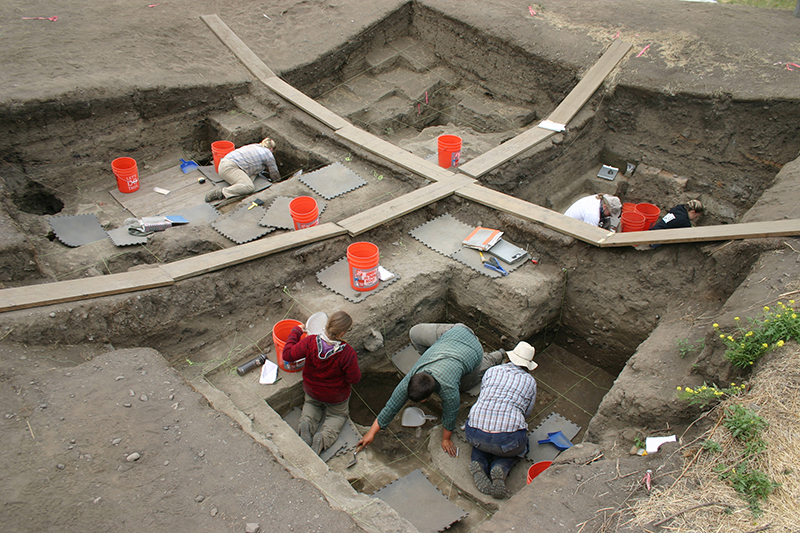
Excavations of Housepit 54 in 2014 provided exciting new insight into the history of this ancient household. This year, our team included eleven undergraduate and graduate students from The University of Montana, one recent graduate of the University of Washington, and two members of Xwisten, the Bridge River Band (Josh Jack and Kat Street). Once again we were pleased to work with Xwisten Experience Tours in educating a range of publics about the archaeology of the Bridge River site and the ancient history of the Middle Fraser Canyon.
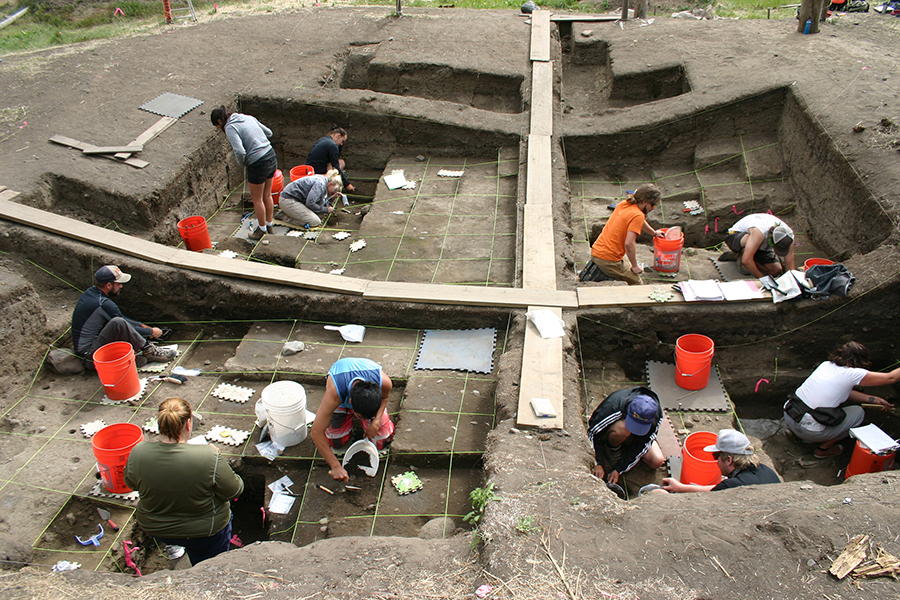
Archaeological findings for 2014 were diverse and provocative. We achieved major strides in reconstructing the stratigraphic history of the house. We recognized that the house may have been initiated over 1400 years ago at a much smaller size, then potentially doubling in size three times before its first abandonment at about 1000 years ago. The pattern of growth within Housepit 54 appears to parallel overall village growth. This offers interesting implications for our understanding of demographic change and village expansion. Next, we recognized some major changes in the organization of family life across eight floors dating ca. 1100-1400 years ago. The older floors (floors IIe to IIh so far) had distinct areas set aside for large storage pits. One sector (on floor IIe in Block B) actually had five large pits placed in a semi-circular arrangement. The shallower floors (IIa to IId) featured smaller and more scattered placement of storage pits. Finally, a wide range of interesting artifacts and faunal remains were recovered. These included a substantial number of dog bones from floors and pits, dog coprolites, a large assemblage of groundstone items (ornaments, slate knives and scrapers, grinding slabs, abraders, and stone bowl fragments), and a distinct human figurine carved from a piece of animal bone. The figurine, which likely dates to about 1250-1300 years ago, is a male, wearing moccasins/boots, pants, a shirt or coat, and a belt. The head is missing and there are dog tooth punctures on the torso and legs. Laboratory research on the Housepit 54 materials will continue to focus on household demography, technology, economy, and social relationships. We expect a final report on the 2014 field investigations to be available by May of 2015.
The excavations were conducted by a somewhat smaller crew in 2013 that once again included many students from The University of Montana and several enthusiastic members of the Bridge River Band. We were joined for three exciting days by the archaeological field school from Hamilton College (Clinton, New York), directed by Dr. Nathan Goodale.
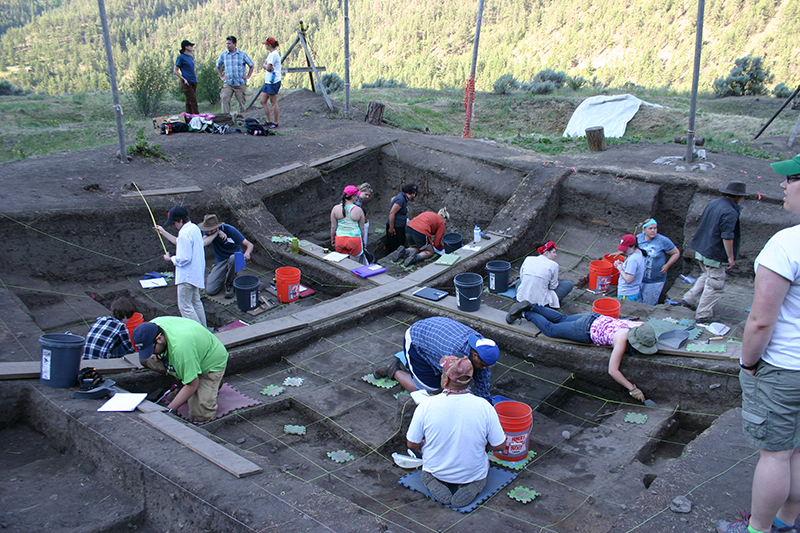
Excavations in the 2013 field season opened the more ancient floors at Housepit 54. While laboratory research is currently underway, it is not too early to state that thousands of stone artifacts and animal bones were recovered from six floors dated 1100-1300 years ago. The floors are remarkably well preserved as thin layers of clay containing intact cooking and storage features and extensive distributions of cultural materials. On-going research seeks to reconstruct the stability and change in plant foraging, hunting, and fishing; social organization as reflected in spatial arrangement of activities on the floors; population growth and decline; variation in trade relations; and the underlying causes of social and economic change.
Excavations of Housepit 54 were initiated in the summer of 2012 focusing on the final floor and roof dated to the late Fur Trade period (1850s). We were pleased have a large crew made up of UM graduate students, field school members, and many members of the Bridge River Band!
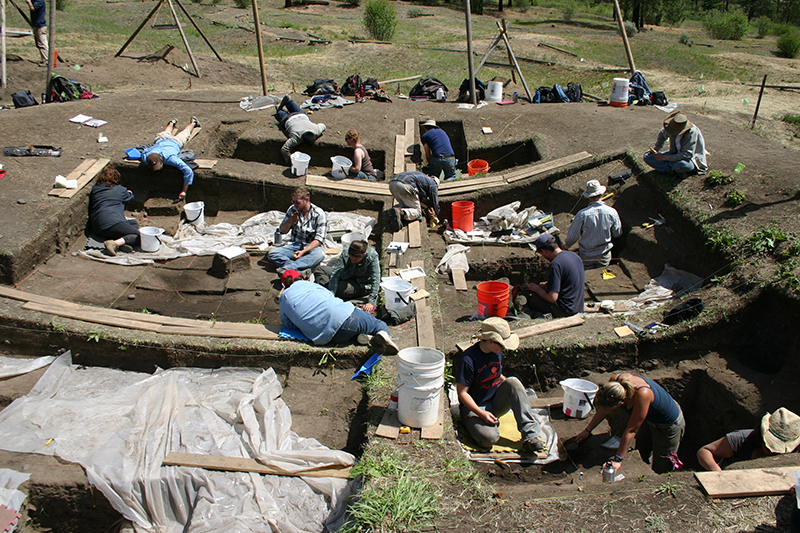
Results of these investigations identified nearly 10,000 stone artifacts, approximately 8000 animal bones, 52 items classified as trade goods of European manufacture, and several house floor features. Study of these items has generated a range of conclusions that will be detailed in a forthcoming book. The Fur Trade floor was organized in activity areas surrounding a large central hearth. Household activities included food preparation and cooking, stone and bone tool manufacture, hide working and clothing manufacture, and undoubtedly a wide range of social activities.
The presence of large numbers of fragmentary mammal bones, about 250 stone hide scrapers, and over 100 arrow points suggests that hunting and hide processing may have been a particularly important activity during this time. One major payoff of hide processing could have been trade for certain European items including glass beads from as far away as Venice, Italy. Clearly the Housepit 54 people we economically active and socially engaged during the 1850s!
